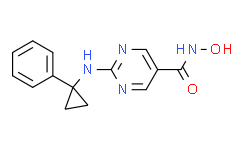| Description: |
ACY-738 is a potent, selective and orally-bioavailable HDAC6 inhibitor, with an IC50s of 1.7 nM; ACY-738 also inhibits HDAC1, HDAC2, and HDAC3, with IC50s of 94, 128, and 218 nM. |
| In Vivo: |
ACY-738 (5 mg/kg) leads to significant increase in α-tubulin acetylation in whole-brain lysates. ACY-738 (50 mg/kg) fails to produce an enhancement of locomotor activity in WT mice tested in a home cage environment[1]. ACY-738 (5 mg/kg) reaches a maximum plasma concentration of 1310 ng/mL at 0.0830 h following treatment. ACY-738 (5 mg/kg BW) alters BM B cell differentiation, but shows no significant effect on IgG and C3 deposition in NZB/W mice. ACY-738 (20 mg/kg) significantly attenuates the severity of proteinuria in NZB/W F1 mice. ACY-738 (5 mg/kg) shows a significant decrease in anti-dsDNA production in NZB/W mice as they aged. ACY-738 (5, 20 mg/kg) attenuates sera IL-1β production as the NZB/W mice aged. ACY-738 (5 mg/kg) significantly reduces glomerular IL-6 and IL-10 mRNA levels by more than 50% while treatment with 20 mg/kg ACY-738 reduced IL-6 and IL-10 mRNA to non-detectable levels[2]. |
| In Vitro: |
ACY-738 (2.5 μM) increases the acetylated (lysine 40) fraction of α-tubulin in RN46A-B14 cells[1]. ACY-738 (10 μM) induces cell death comparable to LBH589 and FK228[3]. |
| Animal Administration: |
Mice are injected i.p. 5 days/week with the vehicle control (DMSO), ACY-738 treatment at 5 mg/kg (low-dose), or ACY-738 treatment at 20 mg/kg (high-dose) beginning at 22-weeks-of-age until euthanasia at 38 weeks-of-age. The total volume injected is 80 μL. Proteinuria and weight are measured every 2 weeks and blood is collected every four weeks for sera analysis. Proteinuria is measured by a standard semi-quantitative test using Siemens Uristix dipsticks. Results are quantified and scored as follows: dipstick reading of 0 mg/dL = 0, trace = 1, 30-100 mg/dL = 2, 100-300 mg/dL = 3, 300-2000 mg/dL = 4, and 2000 + mg/dL = 5[2]. |
| References: |
[1]. Jochems J, et al. Antidepressant-like properties of novel HDAC6-selective inhibitors with improved brain bioavailability. Neuropsychopharmacology. 2014 Jan;39(2):389-400.
[2]. Regna NL, et al. Specific HDAC6 inhibition by ACY-738 reduces SLE pathogenesis in NZB/W mice. Clin Immunol. 2016 Jan;162:58-73.
[3]. Mithraprabhu S, et al. Histone deacetylase (HDAC) inhibitors as single agents induce multiple myeloma cell death principally through the inhibition of class I HDAC. Br J Haematol. 2013 Aug;162(4):559-62. |






















